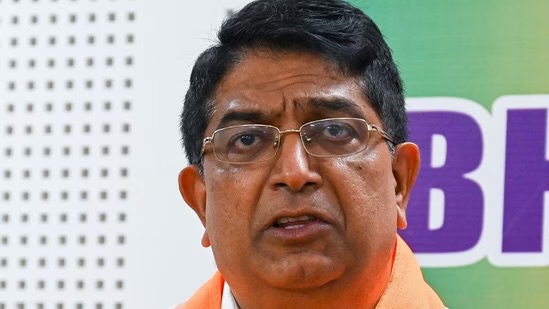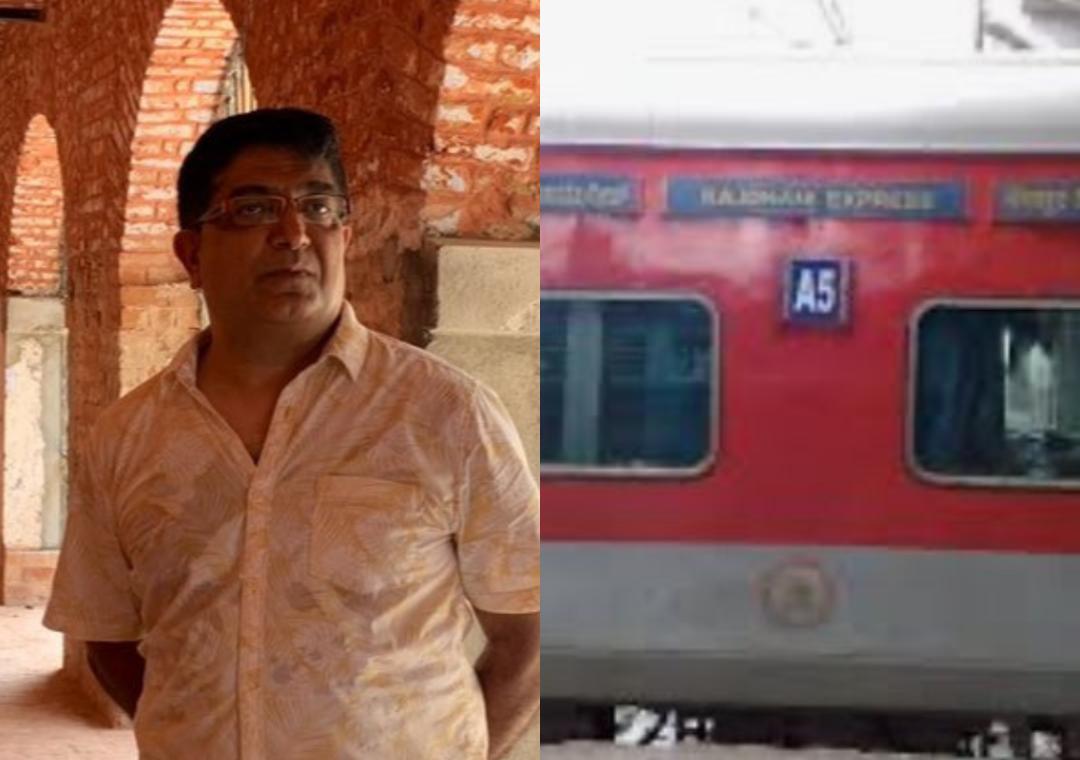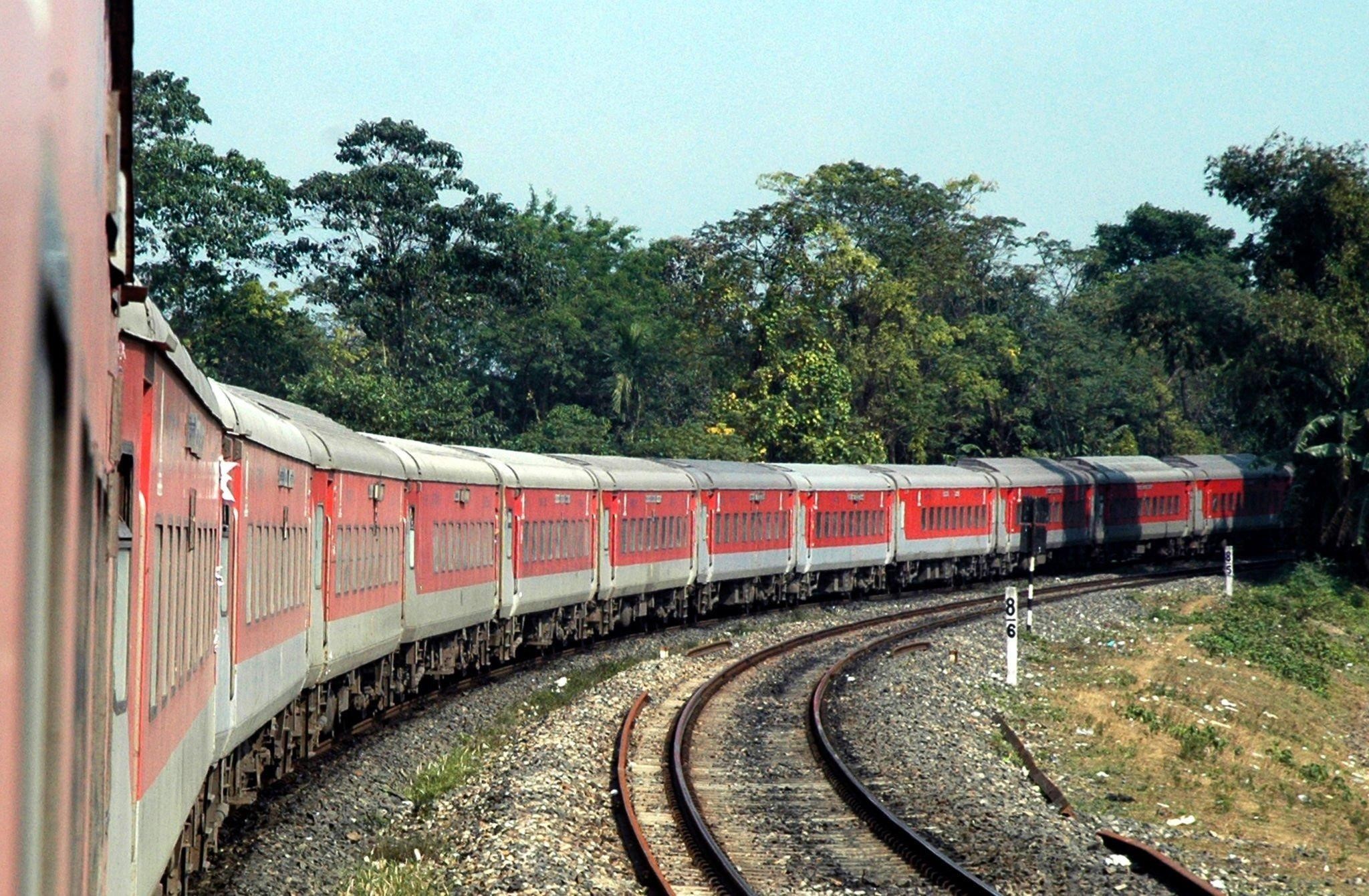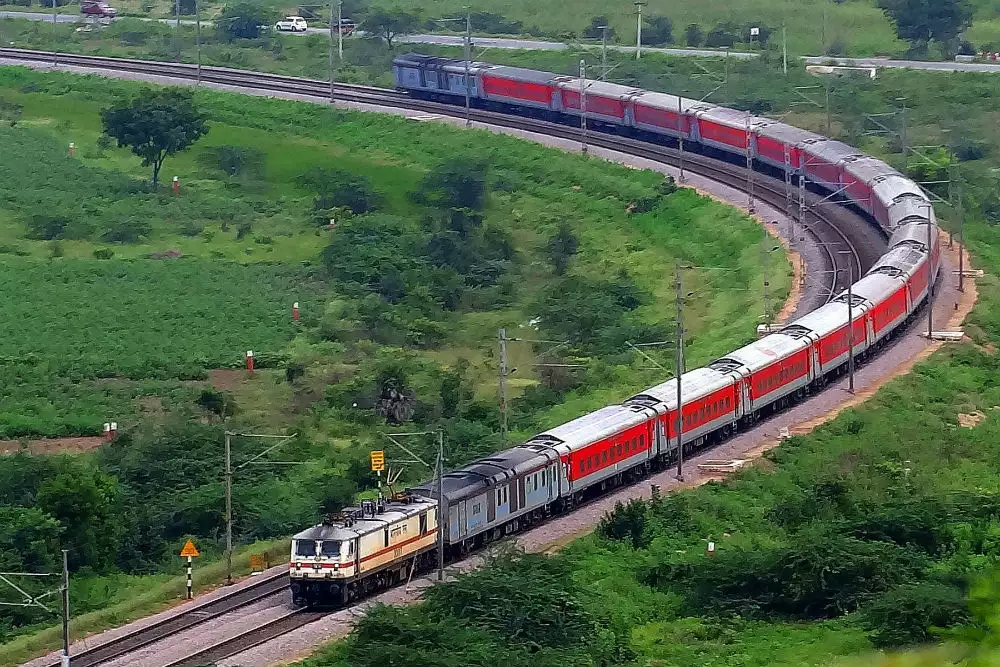Why Do Indian Railways Still Operate On Colonial Infrastructure? Why Are Indian Railways Still Failing In The World’s Fastest-Growing Economy?
The recent criticism by Bhaskar Rao, a BJP leader and former Bengaluru Police Commissioner, for the 8.5-hour delay of the Delhi-Bengaluru Rajdhani Express, has exposed the chronic issues pervading Indian Railways. The poignant question that Rao asked is: "How many decades will you do this for? ”—highlights not just a single incident but a systemic failure within one of the world’s largest railway networks.

When BJP leader and ex-Bengaluru Police Commissioner Bhaskar Rao lashed out at Indian Railways on social media regarding the 8.5-hour delay of the Rajdhani Express from Delhi to Bengaluru, anger was palpable. The poignant question: “How many decades will you do this for?” resonates with millions of Indians who have, at some point, been shortchanged by the country’s rail system.
This one incident is the epitome of the overall inefficiencies within the Indian Railways, the world’s fourth-largest railway network. Carrying over 23 million passengers, more than 13,000 trains run every day. Yet, delays and outdated infrastructure mar it, alongside its operational inefficiencies.
The Rajdhani Express Incident
On the night of November 18, 2023, passengers of the Delhi-Bengaluru Rajdhani Express were stranded at the platform when their scheduled train departure at 9 PM got delayed till 5:30 AM the next morning. The 8.5-hour delay left hundreds – senior citizens, pregnant women, and children – uninformed, without basic amenities or arrangements for an alternative journey.
BJP leader and former IPS officer Rao criticized the lack of communication and questioned the accountability of Indian Railways officials. He pointed out how passengers “trust the railways so much” yet are penalized with such inconveniences.
According to the officials, the cause of the delay was the late arrival of another train. But such excuses only raise more questions than answers.
Why weren’t they prepared for such eventualities? Why weren’t the passengers informed or at least put on their best possible support?
Indian Railways: A Historical Context
A Legacy of Growth and Decline
Indian Railways, born in 1853, was, in its early days, the symbol of progress. It expanded quickly, covering rural and urban areas and spurred commerce, culture, and communication. Yet, over the past few decades, there has been a trend of stagnation and neglect, notably with regards to passenger services.
- 1950-51: Rail network had covered 51,315 kilometres for a much lower population.
- 2021-22: Even as the network has increased to 102,831 km, Indian Railways’ inability to meet the transportation needs of a population that has expanded from 360 million in 1951 to over 1.4 billion today stays common.
Despite having made numerous progressions, the punctuality rate of Indian Railways has steadily declined. Between 2012-2019, punctuality declined to 69% from 79%. This year alone, 1.82 lakh trains ran late.
Chronicle Delays: The Data Speaks
In the first seven months of fiscal 2023-24, cumulative delays across train services spilled over to more than 1.27 crore minutes or over 24 years of lost time. Such delays not only inconvenience passengers but also expose systemic flaws in scheduling, resource allocation, and crisis management.
What Went Wrong?
The whole size of state transport, once the epitome of efficiency and reliability, is Indian Railways, struggling with a host of systemic issues that muddle its growth and operational efficiencies.
This includes the deeply entrenched lack of modern infrastructure, overburdening of the network, imperfection in the management processes, and lack of safety mechanisms-all of which pose an immediate need to improve.
Outdated Infrastructure
Indian Railways is fundamentally based on infrastructure most of which dates back to the colonial era. Modernization attempts notwithstanding, requirements for upgrade far outweigh the upgrade that has been made.
Most tracks and signalling systems were designed for slower, lighter trains.
With the new speed and heavier loads for the trains, this mismatch causes a lot of breakdowns and derailments. For example, most tracks are not yet good enough for any train to exceed 50-60 km/h, way below the globe’s average speeds for passenger trains.
High-speed rail investments are limited to fewer routes, with the much-touted Mumbai-Ahmedabad bullet train being one of the few high-profile initiatives. Meanwhile, the rest of the network continues to rely on outdated facilities-the analogue signalling systems and under-maintained bridges, stations, and rolling stock.
Passenger trains still average a pitiful 45-50 km an hour, compared with 200-300 km/h for high-speed trains in more developed countries like China or Japan. Besides raising travel times, this inefficiency also puts India at a serious disadvantage in freight logistics terms.
Over-stretched Network

Indian Railways is the world’s busiest network but not a system with enough capacity to keep pace with growing demands.
Because over 13,000 passenger trains and 9,000 freight trains run daily on the same tracks in China, with no dedicated freight corridor, it causes uncontrollable delay congestion, along with reduced operational efficiency, due to delayed sideloading of freight trains for the passengers.
Major lines-the Delhi-Mumbai and Howrah-Delhi operate at over 100% capacity, giving very little scope for maintenance or emergencies. This causes cascading delays and increases wear and tear on infrastructure.
Poor Administration
The Indian Railways’ management structure is bugged by inefficiencies in bureaucracy and a lack of cohesive vision. Political intervention and frequent changes at the top level hinder long-term planning. Under new command priorities, key projects are stalled.
Communication between the central railway authority and the regional railway authorities needs to be more cohesive. Projects that need coordination involving two or more agencies invariably experience delays because of conflicting agency priorities, such as electrification of tracks or station redevelopment.
Administrative complexity is prevalent in decision-making, leading to two-year delays in upgrading critical items, such as tracks and safety systems.
Safety still remains an Indian Railways issue. An unending stream of derailments and collision warnings points to systemic flaws.
Whereas India’s peers around the globe have relied on safe automated systems to manage track maintenance, signalling and train movement, the Indian Railways relies on traditional manual inspections. Human failure therefore assumes the risk factor.
As of 2024, the safety system for collision prevention and increased operational safety-the Kavach safety system-has been fitted on only 3% of the network. It is partly due to a lack of funding, logistical hurdles, as well as a general lack of urgency.
Rolling stock and infrastructure continue to be a real and pressing issue for safety. The tracks, bridges, and locomotives often reach or surpass their lifecycle usage time, which causes many breakdowns and accidents.
Cases: Uncovering the Problems and Impacts of Inefficiencies at Indian Railways

The problems of Indian Railways are not abstract; they’re very real, with impacts on lives and livelihoods. The following pages discuss case studies in further detail of significant incidents and delays that exposed system-wide weaknesses in infrastructure, operations, and administration. Cases illustrate the need for reform and the human consequences of inaction.
1. Balasore Train Crash (June 2023)
The Balasore train crash is one of India’s worst railway accidents in recent times, and it also hints at the Indian Railways’ system vulnerabilities.
Background of the Accident
- On June 2, 2023, three trains collided near Balasore in Odisha:
- The Coromandel Express derailed after being wrongly diverted onto the same track due to a signalling error by hitting a stationary freight train.
- This collision sent carriages careening onto a parallel track, where they were struck by the oncoming Howrah Superfast Express.
- The accident killed 298 people and injured more than 900, leaving an appalling scar on hundreds of families.
Root Causes
Some of the systemic failures identified through the investigation include:
- Faulty Signalling: The cause of the collision was a faulty sign that caused the Coromandel Express to change over to the wrong track.
- Inadequate Safety Measures: The railway section lacked the Kavach system, an automatic collision prevention technology that could have prevented the trains from colliding.
- Maintenance Neglect: Frequency and adequacy of checking the signaling equipment need to be completed or completed properly.
Consequences and Reforms
The accident caused widespread anger and the government gave assurances of safety overhauls. Yet, progress remains glacial:
- Only 3% of the Indian railway network is equipped with modern safety systems such as Kavach.
- Examinations revealed chronic under-manning of the technical positions, which caused delayed maintenance and repair.
- The families of the dead were compensated, but the survivors targeted the absence of future rehabilitation services. The Balasore disaster has unearthed the perils of overreliance on old infrastructure and the lack of accountability.
2. Sabarmati Express Derailment (August 2024)
Sabarmati Express derailment in Gujarat brought up to the fore the infrastructural neglect and its peril to passenger safety.
The Case
The Sabarmati Express derailed on August 14, 2024, close to Ahmedabad. Seven coaches were seen derailed. Nearly 34 passengers received injuries, of whom some had serious ones.
Root Causes
- Track Inspection Issues: The initial evidence reported a cracked rail, which did not come under scrutiny due to poor inspection of the track.
- Ageing Infrastructure: The track section had not been upgraded for decades; apart from general wear and tear it had weakened the track in many ways.
- Slow Response: Emergency services arrived at the accident site after more than two hours, aggravating the suffering of injured travellers.
Wider Repercussions
The train derailment brought to light:
- Track modernization is urgently needed in India: more than 40% of the rail tracks are old or worn out.
- Technical staff for routine inspections: there are glaringly insufficient numbers: track inspectors vacancies exceeded 10,000 as of 2023.
- Emergency preparedness: rescue efforts are late in arriving, so that suffering must be faced unnecessarily.
- Although nobody lost their lives, the accident further incorporated fear into the minds of people regarding the safety and reliability of Indian Railways as a mode of transport.
3. The 2022 Agra Rajdhani Delay
While train accidents get highlighted in the media, chronic delays depict operational inefficiencies in the Indian Railways. A case in point is the Agra Rajdhani Express delayed in December 2022
The Incident
The Agra-bound Rajdhani Express, which has the reputation of being one of the most punctual services in the rail network, was late by 9 hours due to fog and mismanagement of operations.
Passenger Experience
Passengers were stranded at Agra Cantt station, many needing access to proper waiting facilities. The most vulnerable groups of passengers-Elderly and their families with small kids-had to spend the bitterly cold winter night on unheated open platforms.
Operational Weaknesses
- Most importantly, passengers only got information about the delay if the hours had passed.
- Many railway stations do not have facilities like waiting areas, seating, or refreshment counters, which heighten passenger distress at almost every level.
- Indian Railways is also indifferent to rerouting trains or rescheduling in the event of disruptions as it will lead to cascading delays.
Lessons Learnt
The accident highlighted:
- The necessity for real-time communication systems to update the passengers during interruptions.
- Improving station infrastructure to make waiting areas more passenger-friendly.
- There is a lack of planning for contingency when weather-related disruptions occur as this is a frequent phenomenon during winters in northern India.
4. The Train-18 (Vande Bharat Express) Accident
India’s pride in presenting the semi-high-speed Vande Bharat Express suffered a jolt in February 2023 when a technical snag left passengers stranded for several hours.
The Story
It was on the New Delhi-Varanasi route, one of the first routes for the Vande Bharat Express. The train screeched to a halt due to an electrical fault. Over four hours later, the stranded passengers were left to enjoy the cool evening breeze.
What’s Gone Wrong?
The train, touted as a symbol of Indian technology, encountered frequent teething troubles, which raised questions about its reliability. Lack of technical skills in the hands of maintenance teams meant delays running into hours for long periods of time.
But the premium passengers, at a price, got a lot of discomfort and some unhappiness on account of serious service quality issues. More broadly While the Vande Bharat Express represents a step towards modernisation, its early setbacks reveal the challenges of integrating new technology into an ageing railway ecosystem.
All these incidents, from Balasore crash to Sabarmati derailment, delay of Rajdhani, and Vande Bharat mishap, testify the deep-rooted problems that Indian Railways is facing. Incidents aimed to emphasise the modernization and accountability that it has so far failed to deliver gave more focus on reforms towards passengers. Unless decisive actions are taken, Indian Railways can end up being a symbol of missed opportunities instead of being a pillar of India’s progress.
The Far-Reaching Implications of Inefficiency of Indian Railways

The inefficiencies within Indian Railways have rippling effects beyond the rail network to the economy, passengers, and public trust.
Economic Losses
The financial cost of delays and inefficiencies in Indian Railways is phenomenal, worth billions of rupees annually. Freight movement, which is the lifeline for revenues earned by the railways, is highly diverted to road transport due to the unreliability of the service.
This shift not only boosts logistics costs—road transport costs are nearly 30-50% higher per ton-kilometre compared to rail—but also exacerbates environmental challenges since trucks generate higher carbon emissions compared to trains. In addition, system inefficiencies in freight scheduling result in supply chain disruptions that disadvantage industry sectors relying on goods delivered within a set timeframe.
The losses are multiplied by underutilised rail infrastructure, where potential revenue remains untapped due to outmoded practices and delays that beset operations.
Passenger Inconvenience
The day-to-day problems of the passengers are a reflection of how ill Indian Railways has been. For the millions who depend on trains for daily commutes and long distances, delays are more than just a small hindrance-they derail lives. Missed appointments, lost business opportunities, and rescheduled plans are commonplace.
To professionals and to students, delay means loss of productivity. In vulnerable groups like older people or families with children, delay is added discomfort during an extended wait. To top this, arranging alternative transportation oftentimes requires high paid costs, adding to the frustration of already strained passengers.
But it is not only this fact, the inability to communicate and provide support during delays makes the passenger experience worse, thereby leaving many leaving the very system they depend on to fend for themselves.
Erosion of Public Trust
Half a century of inefficiencies and broken promises has severely eroded public confidence in Indian Railways. What was once the backbone of affordable and reliable travel in the country is now needing help to maintain its relevance in a competitive transportation landscape.
More and more, passengers consider rail travel unreliable and opt for the more expensive, yet dependable, alternatives of flights or private vehicles. This erosion of trust undermines the railways’ status as a public service and weakens its ability to compete with emerging transport alternatives.
Improving these inefficiencies is not just about improving railway services, but rather critical for restoring economic, social, and environmental benefits that Indian Railways is uniquely positioned to deliver.
Solutions: Where Do We Go from Here?
Indian Railways is the lifeline to millions of people and one of the most significant components of the country’s economy. To stay in tune with the development taking place in India, modernization of the rail network in the form of a comprehensive plan on modernization, safety, digital transformation, and accountability will be essential.
Modernising Infrastructure
India’s infrastructure is the backbone of any railway system, which has failed to keep up with rising demand.
India needs to speed up high-speed rail projects, such as a bullet train on the Mumbai-Ahmedabad route, which may result in quicker travel times and less congestion for both passengers and freight operations.
Many of India’s tracks are a few decades old and, due to their fragility, face periodic maintenance problems and speed curbs. By replacing ageing tracks with newer materials nationwide, safety and efficiency will improve.
Improving signalling systems to automated, centralised technology is essential to preventing accidents and thus optimising railway train schedules. For example, technologies such as the European Train Control System would reduce human errors and overall operational reliability.
Digital Transformation
Technology can transform a service through increased openness and efficiency in its operations and to the passengers.
Indian Railways should implement real-time tracking systems to offer timely information about train schedule, delay and derailment. This would reduce passenger anxiety and, therefore enhance trust.
Artificial intelligence helps optimise the movement of trains by studying traffic trends, weather, and maintenance requirements.
AI-based tools can help avoid tardiness and control resource wastage. Thus, advanced algorithms for dynamic pricing can be integrated with digital platforms for ticket bookings and cancellation to enhance revenue generation and improve customer satisfaction.
Safety First
Safety is one of the most important areas and needs attention as cases such as derailment and collision recurrence occur.
The Kavach system, India’s indigenous automatic train protection technology, must be expanded to cover the entire network by 2030. It can prevent collisions and ensure better train control.
Tracks, locomotives, and stations need to be regularly safety audited for meeting stringent safety standards. Stringent schedules of maintenance as well as inspections can detect potential risks well before accidents occur.
Provide employees with the latest training in responding to emergencies so that rescue and rescue operations are enhanced in case of accidents.
Dedicated Freight Corridors
Freight takes a lion’s share of railway revenue, but it usually faces unnecessary congestion on tracks shared with passenger trains.
The timely completion of these corridors will segregate freight and passenger traffic, increasing operational efficiency. Freight trains can now be moved without delays as attendant to passenger train schedules, and the freed-up tracks can show improved punctuality in passenger train operation.
Connecting freight corridors to major ports can smooth out the transport of goods, promoting economic growth and reducing logistics costs.
Accountability Mechanisms
Establishing accountability frameworks is foundational to making Indian Railways a customer-driven organisation. Serving railway officials and staff on frequent assessments would enhance efficiency to minimise operational lapses. Audits of the administration should actually be carried out concerning safety compliance, punctuality, and passenger satisfaction.
Implementation of a compensation policy for three-hour delays, adopted by European standards can encourage efficiency and ensure accountability. Refunds or travel vouchers to other passengers in circulation would be helpful to regain public confidence. Publishing performance metrics like punctuality rates and accident statistics would be sufficient to galvanise transparency and public examination toward improvement.
How Many Decades?
Bhaskar Rao’s criticism embodies the haze of frustration that many Indians share. Indian Railways is once a proud national institution that has gross inefficiencies whose ramifications lie far beyond. The delay of the Rajdhani Express does not stand alone but is a symptom of deeper structural issues that have to be seen urgently.
As India aims to become a superpower, so must its infrastructure match the best of modern times. Indian Railways needs to focus on safety and operational efficiency and ensure their passengers are satisfied. Only then will it be able to take pride in responding to Rao’s question: “How many decades will you do this for?”




